The female artist I chose to look into is Jenny Sabin, who investigates the intersections of architecture and science and applies insights and theories from biology and mathematics to the design of material structures. One of her works called PolyForm catches my attention immediately when I see it. It is a permanent interactive installation which from a distance and from within, passersby can explore the square structure’s laminated glass walls and jewel-like stainless-steel modules, whose colors and reflections change depending on the time of day, weather and a viewer’s orientation. What’s fascinating about this project is not only its changing colors and beautiful forms, but also the theme embodied in it. By placing an installation like this to make people stop by and interact with it, this sculpture thereby creates an atmosphere in that place to represents the great minds coming together for new possibilities and hope for the future. It is not interpreting human ecology literally but representing it by itself. Like Sabin herself says “this project promotes communication and active exchange across disciplines”.
Category: SectionC
Looking Outwards 09: A Focus on Women and Non-binary Practitioners in Computational Art
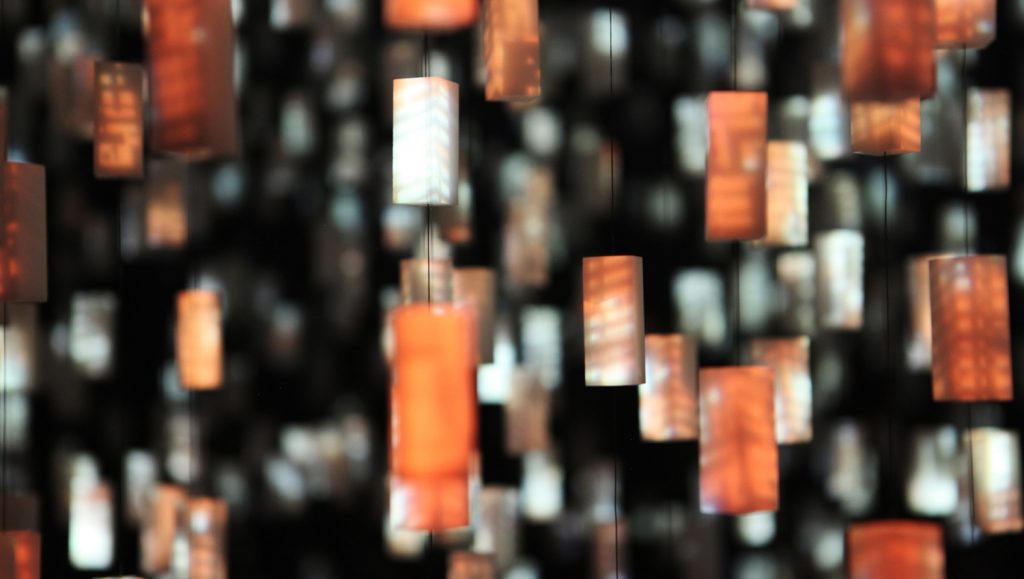
A permanent art installation created in 2012, Assembly is built of acrylic blocks and steel combined with digital emulsion. 5,500 blocks hang in the air, while digital light is projected onto their faces. This allows the spectator to study “a boundary line between digital and natural worlds, experiencing figurations of imaginary digital forms rendered into the limiting error-driven physical system.” The artist is trying to display how for the digital world to exit in the real world, it must bend to the rules of physical existence, while also gaining new possibilities.

Assembly was produced by Kimchi and Chips, a Seoul based art studio founded by Mimi Son and Elliot Woods in 2009. They use a research based approach, especially with volumetric images in fog and 3D projection onto non-design forms.
For Assembly, the production staff are Minjae Kim and Minjae Park. The mathematicians are Daniel Tang and Chris Coleman-Smith.
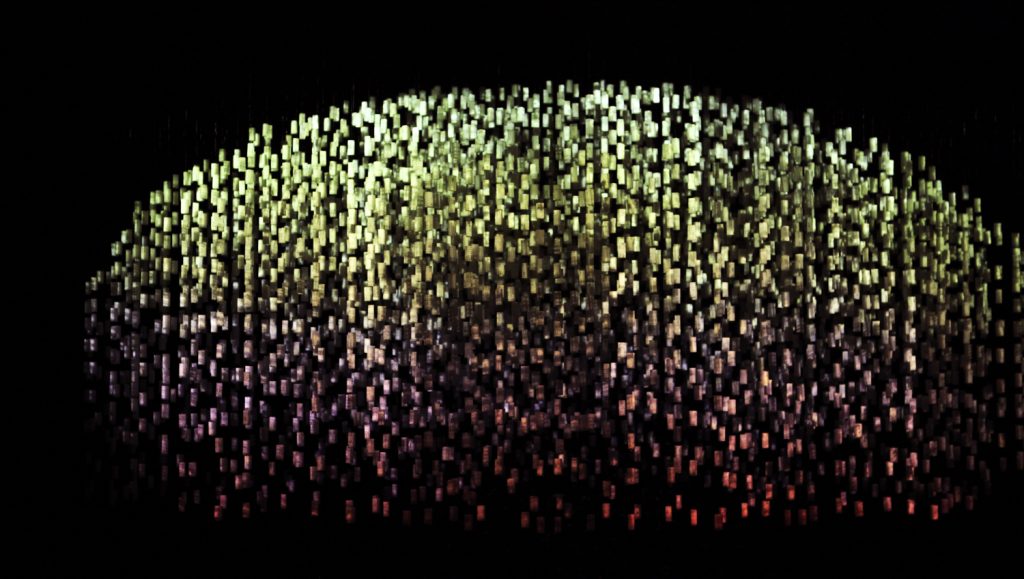
What drew me to this project is how it combines such rigid, physical objects with something as malleable and inconstant as digital light. Until recently, artwork has been restricted to one medium, or groups of similar media. With recent development of so much digital technology, artists have countless more options. Technology is also at the point where combining vastly different mediums is relatively accessible for the average artist, which will allow art to constantly evolve and expand in its possibilities.
Looking Outwards 08: The Creative Practice of an Individual
Stefanie Posavec is a freelance designer focused on data-related design and her work includes data visualization. Her personal work often uses a hand-crafted approach to representations of data derived from language, literature, or scientific topics. Posavec is based in London, England and studied graphic and communication design. Posavec describes herself as a designer and artist whose practice focuses on finding experimental approaches for the communication of information.
I admire how her work makes data more accessible and how the way she works is through the idea that observing is creating. I admire this because it’s important that relevant information be shared with as wide an audience as possible and because she’s able to add visual beauty and humanity to objective realities. I admire her art.park.data project because the result’s pictorial format fits its data collectors (children) and setting well (it’s bold yet simple). I also admire her Writing Without Words project because the final form looks like random tree structures but it is actually displaying quantifiable data that helps the audience look at the subject differently and emphasizes hidden complexities.
To present their work effectively, Posavec provides numerous anorak examples, some personal and some historical, some complex and others quite straightforward; after doing this she makes sure to note the connections between these despite the first-glance differences. I can learn to remember to tie things back to a general theme, as she did during her presentation when relating back to her theme of making (make sense, make a connection, make a memory).
LO 8
Eyeo 2019 “Feeling at Home”
Lauren McCarthy
Lauren McCarthy is an artist, the creator of the p5.js library, and an associate professor at UCLA. According to her website her practice “examines social relationships in the midst of surveillance, automation, and algorithmic living”. In her lecture for eyeo she talks about a couple of her projects. These include a service that allows people to request to be followed by her for a day, a suite of smart-home devices called Lauren that she personally monitors and controls, and video of a series of dates in which she paid Mechanical Turk workers to watch her and give her live advice. I admire how her projects tend to be objectively hilarious, but also offer really novel ways of considering our relationship to technology. I also appreciate how within her talk she discusses a number of her works, but also ties them together as part of a larger narrative about her practice. She successfully avoids the artist talk becoming just a list of projects, but still gives us a good overview of her work.
LO 08: The Creative Practice of an Individual
In this video, McCarthy talks about how homes can be considered as smart humans through her various experimentations.
Lauren McCarthy, as known as the creator of p5.js, is an artist based in Los Angeles exploring how, in today’s society, subjects of surveillance, automation, and network culture influence our social relations. McCarthy claims that human beings are encouraged to interact with algorithms everyday, further critiquing the tensions between social and technological systems, as well as intimacy and privacy. In particular, I found her style of generating art very phenomenal, especially in her work “LAUREN”, with her attempt to perform as a human version of smart home intelligence Amazon Alexa, and later remotely monitoring over the people in their residences to explore the ambiguous relationship between human and machine. In her works, McCarthy employs many of today’s networked electronic smart devices, such as televisions, computers, faucets, and cameras, in which conveys strange, uncanny feelings by intentionally showing the perspective of a camera with artificial intelligence, when a person is being “watched” 24/7 even at home. Home is where everyone should feel the most comfort, safe, and secure; yet, McCarthy contradicts this claim by presenting us with discomfort and unease. I absolutely admire how she looks at our everyday commonplaceness into such intriguing mismatch relationship we experience using today’s technology.
Reference: https://lauren-mccarthy.com/ & https://lauren-mccarthy.com/LAUREN
LO-The Creative Practice of an Individual
The project speech I choose to listen to is NEW DOORS OF PERCEPTION: EXPLORATIONS INTO MIXED REALITY by Mike Tucker in 2019. Mike Tucker, a special effects expert, is an Interactive Director at Magic Leap, a company focused on creating the future of Spatial Computing. His work explores the space of interactive arts and music. In his speech, he talks about his journey with hand and eye tracking, optics, and spacial controllers involved in his process of developing Tónandi, an interactive, spatial music experience. Basically, Tonandi is a spacial computing interaction system which people could actually manipulate by hand to create varying soundwaves and visual effects. The reason why Tucker wanted to create something like it is that there was a bottleneck fo senses, and he wanted to break down people’s expectations on how visual and audio information were perceived by human beings. I am really impressed by the precision of their equipment’s in tracking human eye and body movements. Usually, our eyes capture things, and our Brian perceived that information in a speed faster than we thought it did. However, their top-notch depth sensor and designed systems to scan the surroundings constantly are able to construct rules in behaviors in an environment. This practice showcases how we could break traditional way of seeing the world and improve our view of the world. Also, it marks the new step of interactive and immersive combination of reality and visional information. Most importantly, I really like the way he narrates the whole project. It’s like developing the project with him from the start, one step by anther. The whole process makes me feel engaged.
Looking Outwards: The Creative Practice of an Individual
Today I took a look at Lucianne Walkowicz’s talk during the 2017 Eyeo Festival. She presented her work on astrobiology at the Adler Planetarium in Chicago. Her work explores the ethics of Mars Exploration, magnetic activity, and how stars influence a planet’s suitability as a host for alien life, and specifically how to use advanced computing to discover unusual events in large astronomical data sets. Walkowicz does talks and blogs with large organizations on the topic of Mars colonization and the ethics surrounding the topic. She explores topics like Decolonizing Mars, how police will solve murders on Mars, and the digital dark age! Walkowicz uses methods like interactive and dynamic graphics as well as gestures to keep the audience’s retention. Her work is displayed in an easy and intuitive way to help me stay on track and anticipate what she’s going to say next.
Project 07: Composition with Curves
// Jiyeon Chun
// Section C
// jiyeonch@andrew.cmu.edu
// Project-07-Project
var nPoints = 100;
function setup() {
createCanvas(400, 400);
background(242, 140, 86);
frameRate(20);
}
function draw() {
push();
//make origin the center of canvas
translate(width/2, height/2);
drawEpicycloidCurve();
pop();
}
function drawEpicycloidCurve() {
//Epicycloid:
//https://mathworld.wolfram.com/Epicycloid.html
var x;
var y;
var a = mouseX / 5;
var b = a / int(mouseY / 25);
stroke(255);
strokeWeight(.5);
noFill();
beginShape();
for (var i=0; i<nPoints; i++) {
var t = map(i, 0, nPoints, 0, TWO_PI);
x = (a+b)*cos(t)-b*cos(((a+b)/b)*t);
y = (a+b)*sin(t)-b*sin(((a+b)/b)*t);
vertex(x,y);
}
endShape(CLOSE);
}
function mousePressed() { //press mouse to clear canvas and restart
background(242, 140, 86);
}My project is a program that allows the user to build up a composition using their interaction with the epicycloid curve with their mouse movements. I started off with other curves at first, however, some of the others didn’t offer as many change-able variables, as I wanted the program to be very dynamic upon the movement of the mouse. After putting the curve into my program, I took away the background from the draw function so that the canvas could keep a “history” of the mouse movement every frame, creating a composition over time in which the canvas has responded to the user’s mouse movements and the user to the canvas’ current composition! Here are just a few of the infinite amount of possible compositions:
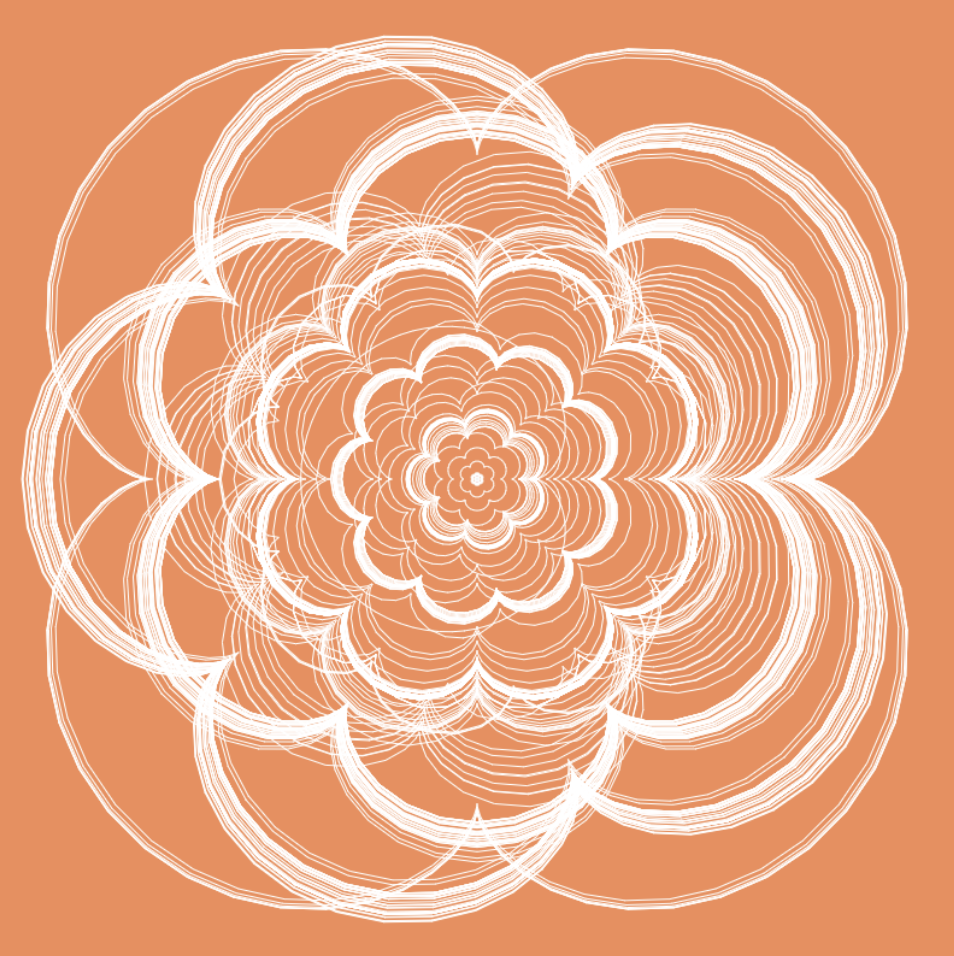
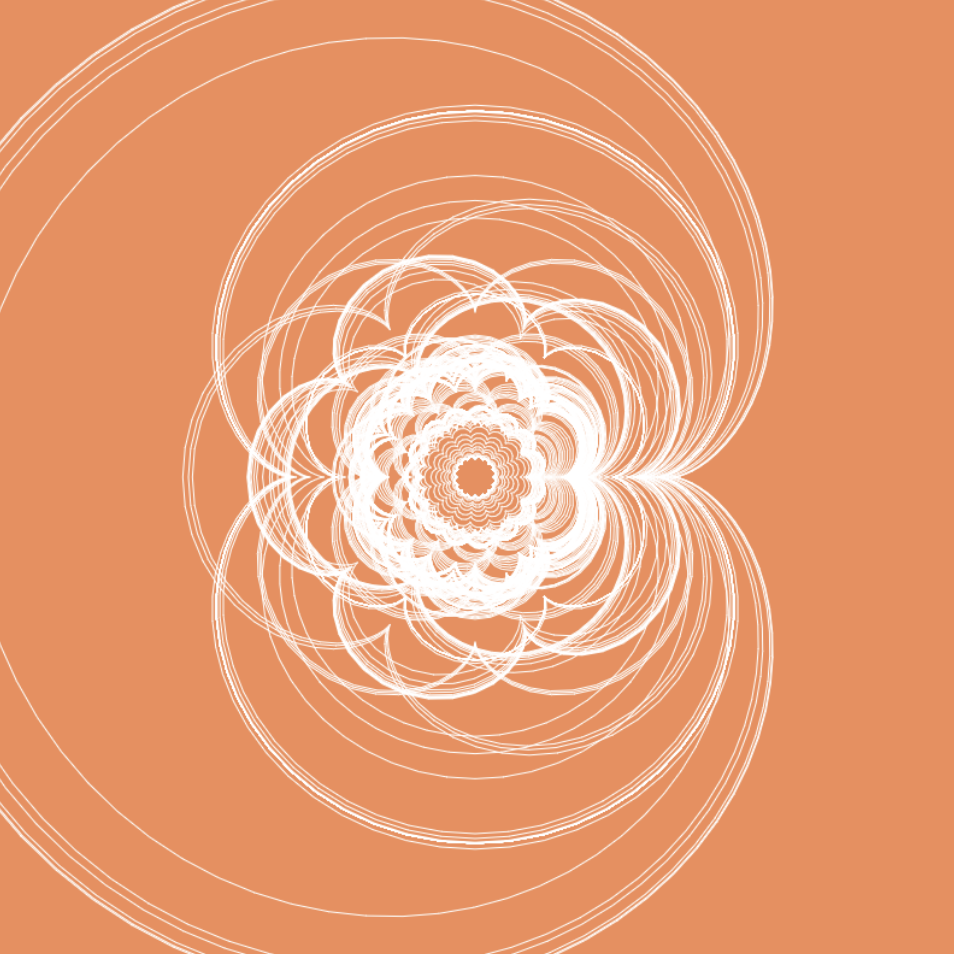
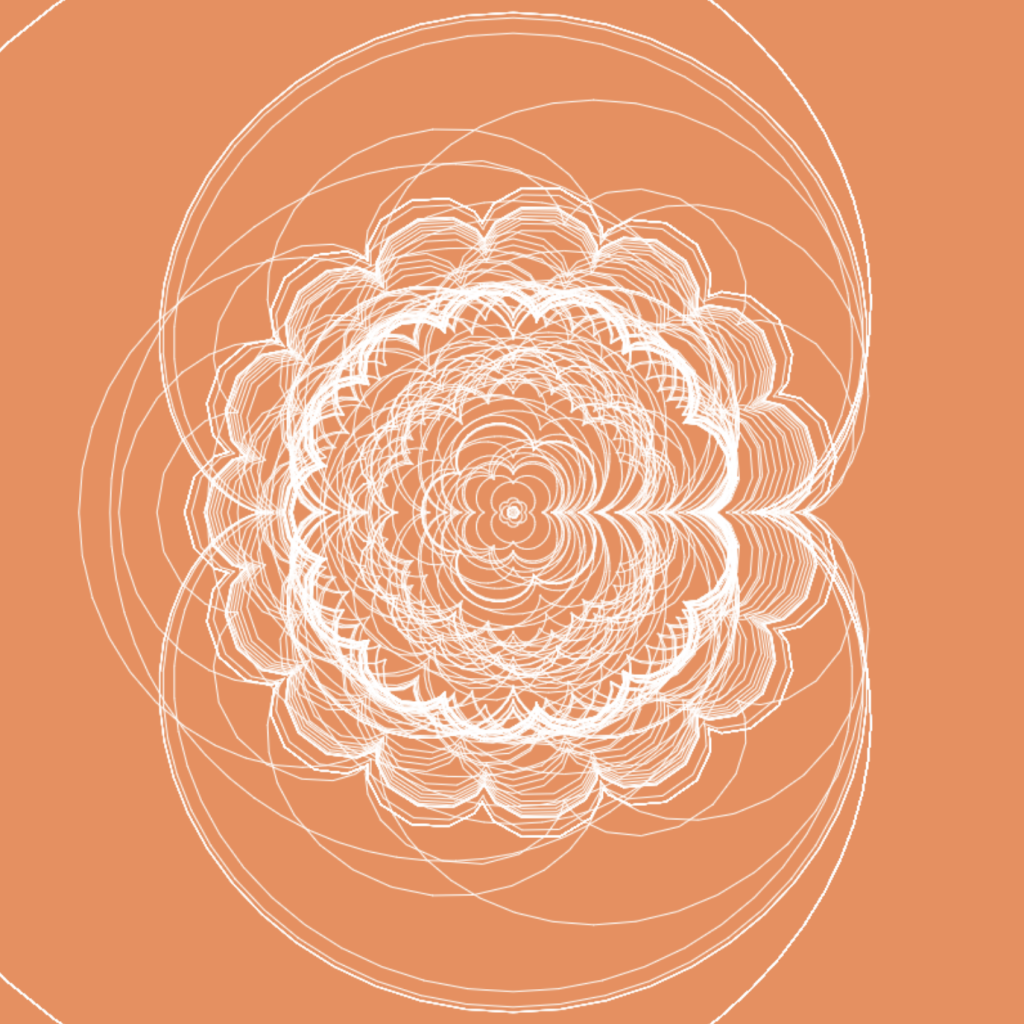
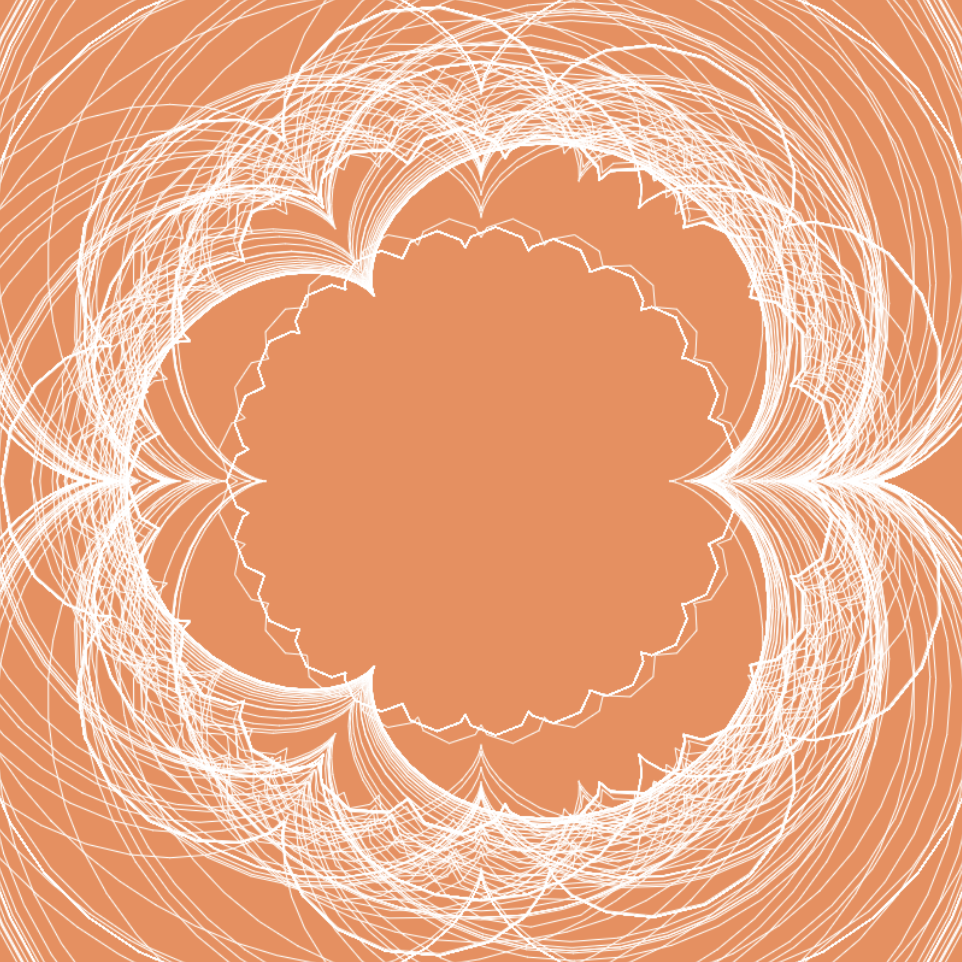
LO: Information Visualization

This Data Visualization, by the group Stamen Design, is a visualization of the atlas of human emotions, designed for the Dalai Lama and scientist Dr. Paul Ekman. It features scholarly findings about emotions and maps it into a series of graphs and interactions on their live website, which brings in different factors such as emotions, triggers, and responses to map how different triggers may cause different emotions in us. For the data itself, the studio and Ekamn conducted a peer-reviewed study among other emotion-studying scientists called “What Scientists Who Study Emotion Agree About,” from which they derived that five emotions in particular are considered and widely acknowledged as universal regardless of culture: anger, fear, sadness, disgust, and enjoyment. I admire that the project uses computation and code to map something so human, visceral, and natural as emotions themselves, and I particularly enjoy the way they graphed the different states of emotions from least to most intense, using shapes, colors, and line qualities that help visualize the emotions themselves, which also point to the design studio’s artistic sensibilities beyond simply plotting data points.
LO 08:
Eyeo 2019 – Refik Anadol from Eyeo Festival on Vimeo.
Refik Anadol is a director and media artist, who works with site-specific public art that uses a parametric data sculpture approach, and live audio and visual performances that use immersive installations. He was born in Istanbul, Turkey, and currently lives and works in LA, California.
He describes himself as being intrigued by how the transformation of subjects in contemporary culture requires rethinking how we perceive space from an aesthetic, technical, and dynamic viewpoint. He also explores embedding media arts into architecture and encourages viewers to visualize alternative realities by presenting the possibility of redefining the functionality of architectural spaces. Anadol suggests that all spaces and facade have the potential to be a canvas for a media artist.
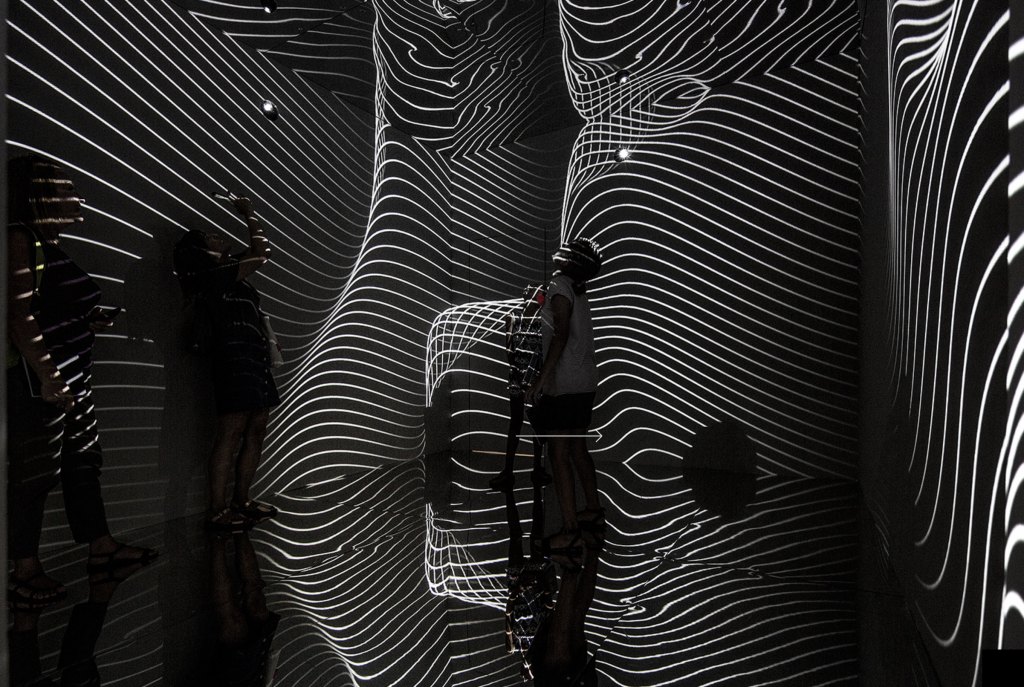
His body of work includes a lot of immersive indoor art installations and outdoor/public art installations, most of which use visual media based upon algorithms and data. I admire how he views the facades and spaces of architecture as potential for media artwork. Public art has a lot of potential to change a community for the better, while also exposing children in lower income communities to possibilities like art.
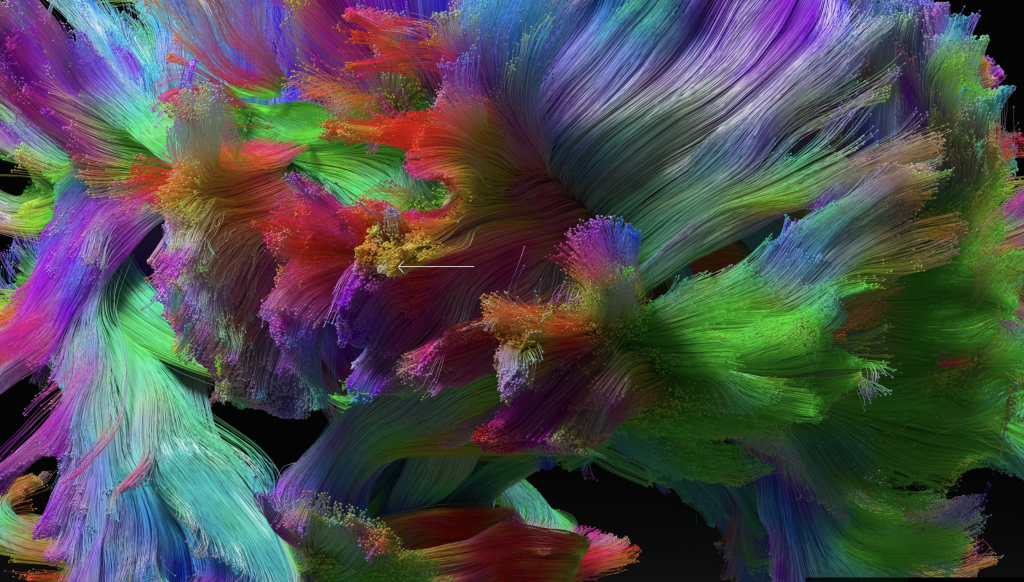
I liked that he explained his own journey in terms of unique mentors and experiences that had helped him along the way. It helps explain how he got to where he is, while also exposing the audiences to many other helpful resources. Presentation wise, he utilized humor, quotes, and compliments (to his mentors) in such a way that his presentation was very dynamic.
![[OLD SEMESTER] 15-104 • Introduction to Computing for Creative Practice](../../../../wp-content/uploads/2023/09/stop-banner.png)